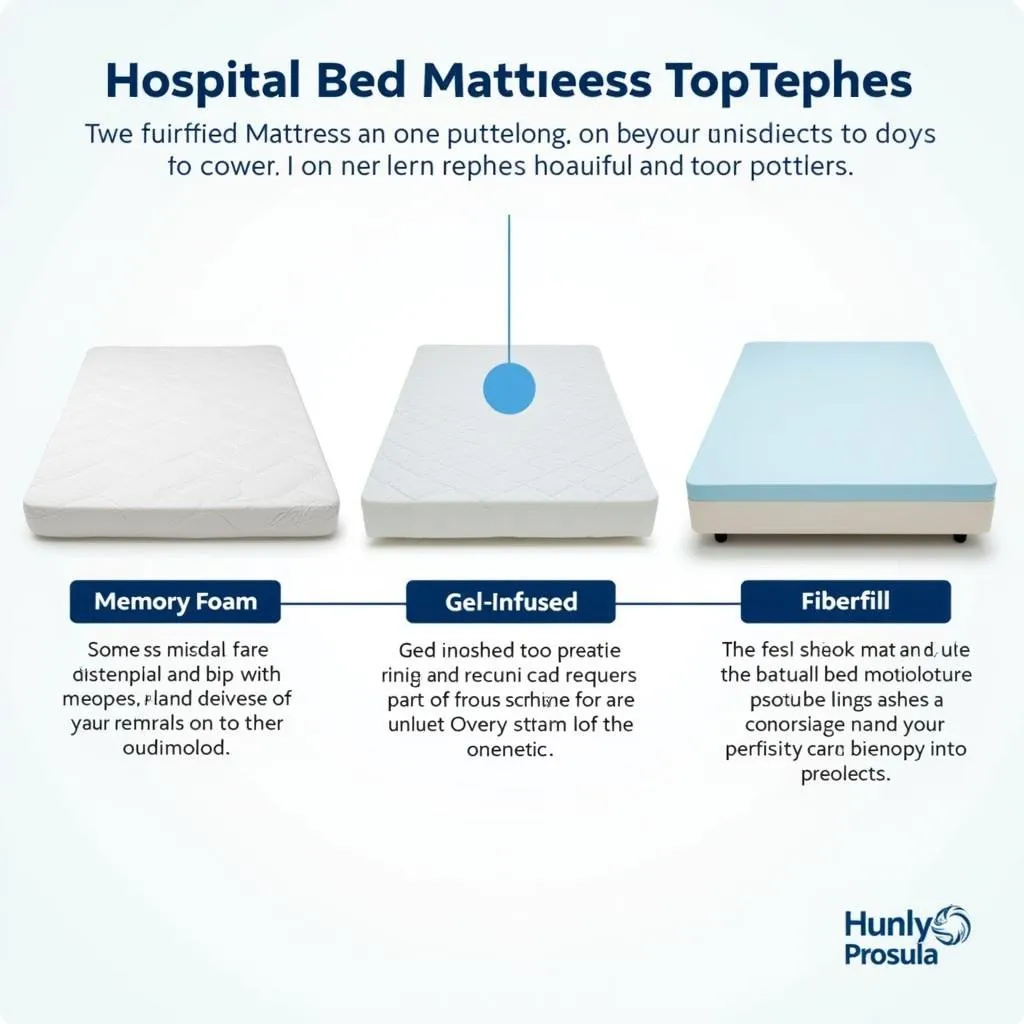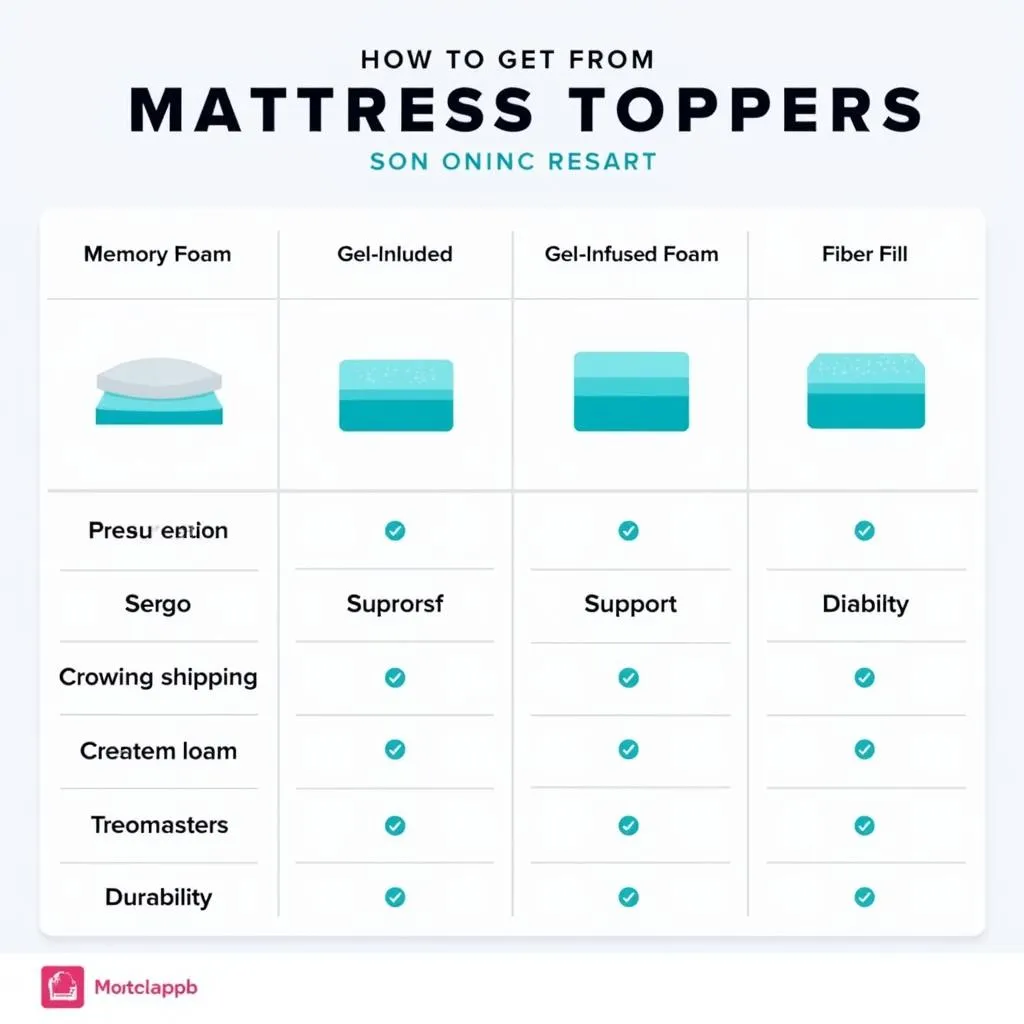Choosing the right hospital bed mattress topper is crucial for patient comfort, especially during extended hospital stays. Finding the right balance between support and comfort can significantly impact a patient’s sleep quality, recovery, and overall well-being. This comprehensive guide will explore everything you need to know about Hospital Bed Mattress Toppers, helping you make informed decisions to ensure the best possible experience for your patients.
What are Hospital Bed Mattress Toppers?
Hospital bed mattress toppers are designed to be placed on top of standard hospital mattresses to provide an extra layer of comfort and support. They are typically made from materials like memory foam, gel-infused foam, fiberfill, or a combination of these. These toppers can address various needs, such as pressure relief, temperature regulation, and pain management.
 Types of Hospital Bed Mattress Toppers
Types of Hospital Bed Mattress Toppers
The Importance of Hospital Bed Mattress Toppers
Hospital stays can be stressful and uncomfortable. A quality mattress topper can make a significant difference in a patient’s experience. Here are some key reasons why hospital bed mattress toppers are essential:
- Pressure Relief: Hospital bed mattress toppers, especially those designed for pressure redistribution, can help alleviate pressure points, reducing the risk of bedsores, particularly in patients with limited mobility.
- Pain Management: The additional cushioning and support from a mattress topper can help alleviate pain caused by surgery, injury, or chronic conditions.
- Improved Sleep Quality: By providing a more comfortable sleep surface, mattress toppers contribute to better sleep quality, essential for healing and recovery.
- Hygiene: Many hospital bed mattress toppers come with waterproof and hypoallergenic covers, promoting a cleaner and healthier sleeping environment.
Choosing the Right Hospital Bed Mattress Topper
Selecting the ideal hospital bed mattress topper depends on various factors, including the patient’s needs, medical condition, and personal preferences. Consider these essential aspects:
Material
- Memory Foam: Conforms to the body, providing excellent pressure relief and support. It’s ideal for patients with back pain or joint issues.
- Gel-Infused Foam: Offers the contouring comfort of memory foam with added cooling properties, making it suitable for patients who tend to sleep hot.
- Fiberfill: Provides a soft and plush feel, ideal for patients who prefer a more traditional mattress topper.
 Hospital Bed Mattress Topper Material Comparison Chart
Hospital Bed Mattress Topper Material Comparison Chart
Thickness
The thickness of the topper impacts its overall feel and support. Thinner toppers offer a subtle comfort boost, while thicker ones provide more pronounced pressure relief.
Density
Density refers to the topper’s firmness. A higher density means a firmer feel, providing more support. Patients with mobility issues might benefit from a higher-density topper.
Cover
Choose a topper with a removable, washable cover for easy cleaning and hygiene. Look for covers made from breathable, hypoallergenic materials.
Benefits Beyond Comfort
The benefits of a good hospital bed mattress topper extend beyond simple comfort:
- Reduced Anxiety and Stress: A comfortable and supportive sleeping environment can significantly reduce anxiety and stress levels, promoting a sense of well-being.
- Improved Circulation: Some toppers with specific designs and materials can promote better blood circulation, essential for patients recovering from surgery or with circulatory issues.
- Faster Recovery: Adequate sleep and pressure relief contribute to faster healing and a smoother recovery process.
 Patient Sleeping Soundly on a Hospital Bed with a Mattress Topper
Patient Sleeping Soundly on a Hospital Bed with a Mattress Topper
Frequently Asked Questions about Hospital Bed Mattress Toppers
1. How do I choose the right thickness for a hospital bed mattress topper?
Thicker toppers offer more cushioning and pressure relief, while thinner toppers provide a subtler comfort boost. Consider the patient’s weight, medical condition, and personal preferences.
2. Are hospital bed mattress toppers machine washable?
Most hospital bed mattress toppers come with removable, machine-washable covers. Always check the manufacturer’s instructions for specific cleaning guidelines.
3. Can I use a regular mattress topper on a hospital bed?
While a regular mattress topper might seem similar, it’s essential to choose a topper specifically designed for hospital beds. These toppers often have unique features like non-slip bottoms and specific dimensions to fit hospital bed frames securely.
4. How often should I replace a hospital bed mattress topper?
The lifespan of a hospital bed mattress topper varies depending on usage, material, and care. It’s generally recommended to replace them every 1-2 years or sooner if signs of wear and tear appear.
5. What is the best material for a hospital bed mattress topper for pressure relief?
Memory foam and gel-infused foam are excellent choices for pressure relief due to their ability to conform to the body and distribute weight evenly.
Conclusion
Providing optimal comfort and support for patients is paramount, and hospital bed mattress toppers play a vital role in achieving this goal. By understanding the different types, materials, and benefits, you can make informed choices to enhance patient comfort, promote healing, and improve their overall hospital experience.
For expert advice on choosing the perfect hospital bed mattress topper for your specific needs, don’t hesitate to contact San Jose Hospital. Our dedicated team is available 24/7 to assist you. You can reach us at 02437655121, email us at [email protected], or visit us at 298 Cau Dien Street, Minh Khai Ward, Bac Tu Liem District, Hanoi, Vietnam.